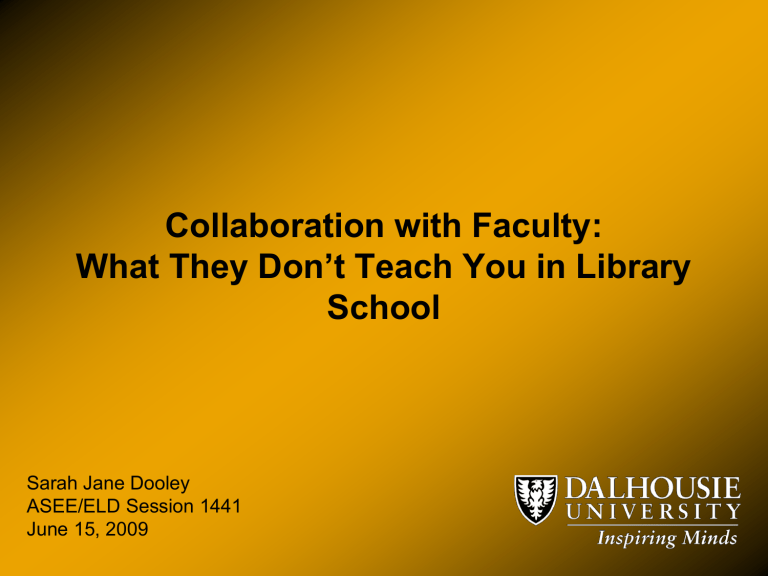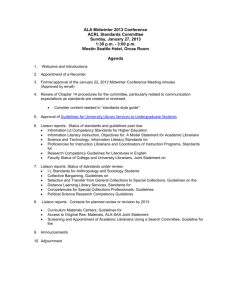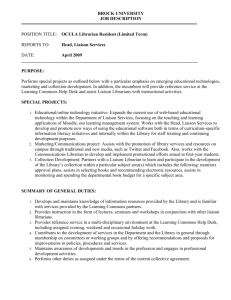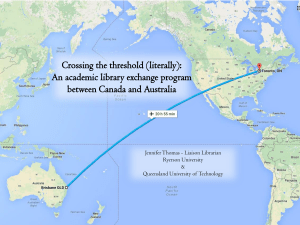Collaboration with Faculty:What They don't Teach You in Library

Collaboration with Faculty:
What They Don’t Teach You in Library
School
Sarah Jane Dooley
ASEE/ELD Session 1441
June 15, 2009
Outline
Introduction and background
Collaboration
Library School and networking
Workplace challenges and strategies
Recommendations
Future of collaboration
Conclusion
Introduction
Can be challenging making connections as a new librarian
Establishing productive relationships with faculty
Needed to succeed in liaison work
Supports career advancement
Networking and collaboration play in integral role
Library School curriculum did not sufficiently prepare me
Will offer recommendations and approaches
Background
Sexton Library, Dalhousie University
Engineering, Architecture & Planning
Sexton Campus started as its own institution
Approximately 1,900 of 16,000 students in total
Informal, small school/work environment
Library is in close proximity to departments
Librarians at Dalhousie
Librarians are faculty members
Collaboration with teaching faculty
Crucial to success on the job
Supports portfolio for promotion/tenure application
Fostering connections is important
Information literacy programs
Collection development
Professional development
About Me
Graduated with MLIS from Dalhousie in 2005
Interned at the Sexton Library 2003-2005
Liaison Librarian, 2005-Present
Subjects: Biological, Chemical, Environmental, Petroleum
Engineering, Food Science
Coordinator Reference & Promotion/Outreach
Photo used under creative commons license: http://www.flickr.com/photos/wonderferret/2900631165/
Collaboration
Librarianship thrives on collaboration
Involves mutually beneficial outcomes for librarians and faculty
Promotion of library resources
Increased library usage
Higher quality research
Collaboration
Collaboration outcomes will lead to:
Success in day-to-day liaison duties
Development of peer-level relationships with faculty
Library School and “Networking”
Curriculum did not include liaison work as topic
Disconnect with idea of networking as it relates to the job
Professional Partnering Program
Formal and informal settings arranged by the school
Networking with other librarians
Centered around the job hunt
Challenges in the Workplace
Photo used under creative commons license: http://www.flickr.com/photos/afgeneral/17455183/
Challenges in the Workplace
Unfamiliarity with how to approach faculty
No networking experience outside the library profession
Limited subject and program knowledge
Some programs had unsuccessful attempts at collaboration in the past
“ To be an effective collaborator, you must learn to think of yourself as a networker”
(Jeffries, 2000)
Overcoming Challenges and Making Connections
Informal networking experience can be a basis for a more formalized setting
Process of “learning by doing”
Demands enthusiasm for self education
Getting to know faculty and organizational culture
Some guidance from co-workers
“In collaboration endeavours, a librarian has to be the introducer and the
catalyst, as many faculty are not aware
of existing options.”
(Stoddart et al., 2006)
Overcoming Challenges and Making Connections
Be proactive and enthusiastic
Informal approach is more effective on Sexton Campus
Maintain a high level of professionalism
Show genuine interest in students and their success
Initiate collaborative projects
Be persistent and assertive
Strategies for Collaboration
Start by getting to know faculty, students and research interests
Foster two-way communication
Focus on repeat customers
Present yourself as the resource expert and invite faculty to contact you directly
Become their “go-to”
Photo used under creative commons license: http://www.flickr.com/photos/sixteenmilesofstring/3232973518/
Interpersonal and Communication Strategies
Explore different avenues of communication (i.e. email, in person, etc.)
Gain credibility through liaison opportunities
Reference and research assistance
Build rapport and create peer-level relationships with faculty
Attend social events: campus events, banquets, coffee/drinks/lunch
Strategies Continued
Create opportunities to network
Become more visible on and offline
Create lasting partnerships
Creating Opportunities to Network
Develop more in-depth relationships to open doors for instruction opportunities
Assist in program development
Collaborate on library assignments for students
Never turn down an opportunity to guest lecture
Attend faculty meetings
Attend student thesis defense
Attend student conference
Becoming Visible
Offline
Put a face to the library
Informal communication
Face-to-face meetings
Attendance at social events and faculty meetings
Online
Send out regular emails
Facebook presence
Libguides promotion
Net “working” It
Photo by Dalhousie University Photographer Nick Pearce
Creating Lasting Partnerships
Take a leadership role
Participate in campus-wide activities
Volunteer for events
Meet future collaborators
Photo by Dalhousie University Photographer Nick Pearce
Recommendations
Workplace
Formalize a mentoring program
Provide documentation to support liaison work
Create a set of guidelines to help set goals for new librarians
Experienced librarians should set an example
Encourage involvement in other programs (ASEE-ELD, or SLA)
Recommendations
Library School curriculum
Devote more time to topic of liaison work
Networking outside library profession
Teaching faculty
Foster collaboration and maintain connections
Spread the word about a successful connection with liaison
Keep an open mind to collaborative web technologies
Future of Collaboration
Technology presents more innovative ways to collaborate
Involve and educate faculty
Collaborative web technologies
Libguides
Widgets in Blackboard Learning System (BLS)
Why not involve faculty in content creation?
Groups for courses
Libguides Application
Library Fan Pages
Conclusion
Learned most on the job
Mentoring program could ease transition for new librarians
Did not realize importance of networking until on the job
Key elements to successful program of collaboration:
Maintaining your visibility
Creating opportunities
Forging lasting partnerships
Conclusion
Improved faculty-library relationships
Created opportunities to enhance portfolio for next promotion
Exploration into new technologies will continue
Relationships will continue to strengthen and evolve




